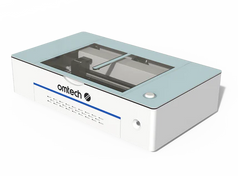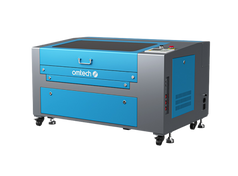A Beginner's Guide to Etch Glass
Glass etching represents a captivating fusion of creativity, precision, and craftsmanship, enabling the creation of unique and visually striking designs. Among the myriad applications within the engraving community, glass stands out as a favored medium for many enthusiasts.
This technique empowers users to infuse their creations with sophisticated and memorable embellishments, suitable for a wide array of items such as wine glasses, photographs, plaques, and various glassware concepts.
Unlike vinyl applications, designs etched onto glass boast exceptional durability, resisting fading and peeling, while remaining safe for both dishwasher and microwave use. For those new to the realm of laser engraving, the question often arises: how does one begin etching glass as a novice?

Glass Etching Techniques and Exploration
Various methods exist for the art of glass etching. Manual approaches involve the use of glass etching cream or rotary tools, providing beginners with a platform to experiment with glass as a creative medium. However, the utilization of a CO2 laser engraver has emerged as a popular and enjoyable method that crafters of all skill levels can engage with. In addition to delivering swift results, laser engravers offer efficiency and cost-effectiveness, negating the necessity for harsh chemicals or high temperatures, while ensuring a safe and user-friendly operation.
For individuals intrigued by the prospect of mastering glass etching akin to a seasoned professional, but uncertain about where to commence, delving into the process of selecting the most suitable machine to bring their designs and ideas to fruition is essential.
Mastering Glass Etching with a Laser Engraver
The inception of laser engravers dates back to the early 1960s, with the advent of focused CO2 laser beams for laser cutting following in 1967. Today, laser engraving has evolved into a global phenomenon, serving as a swift and efficient option for CNC machinists, woodworkers, metalworkers, and beyond. This technology has opened up new horizons for users, facilitating the exploration of avenues such as laser-etched glass. Leveraging a laser engraver stands as a preferred method for inscribing names, messages, logos, and images onto glass surfaces.
The operational principle of a laser engraver revolves around the utilization of a carbon dioxide mixture that generates a long-wave infrared light, heating the glass to induce chipping at a depth not exceeding 0.001 inches. The low-powered laser beam delicately warms the glass, heating the silicon (sand, a primary component) and any other metals present within the glass. The microscopic etching chips manifest as the water and heat confined within the glass expand upon exposure to heat in the designated area. Due to the laser beam's lower intensity relative to most lasers, the glass remains intact, resulting in an elegant, frosted appearance. For comprehensive guidance on mastering the art of glass etching, peruse our Glass Application Guide.
Advantages of Laser Etching
Laser etching offers a multitude of advantages, including:- Precision: the laser beam engraves intricate designs with utmost precision, ensuring consistent replication when necessary.
- High Efficiency: laser beams operate swiftly and seamlessly. Some laser engravers feature dual laser heads to bolster productivity, particularly for projects requiring high volume output.
- Enhanced Productivity: CO2 laser engravers excel in cutting thicker materials, boasting rapid piercing performance and expedited straight-line cutting.
- Consistency: designs stored as files can be reproduced consistently, maintaining identical size, height, and dimensions.
- Reduced Environmental Impact: laser engravers eliminate the need for harmful chemicals that could contaminate water systems or vaporize into the atmosphere. Any dust particles emitted are promptly vaporized by the laser beam.
- Safety: laser engravers are operated at a safe distance from users. Safety features encompass an emergency stop button, built-in ventilation, and a sepia-tinted observation window safeguarding eyes from direct exposure to the laser beam.
- Versatility: laser engravers exhibit compatibility with an array of materials, including wood, leather, acrylic, and metal.
The wattage of a CO2 laser engraver spans from 30W to over 200W, offering varying strengths and speeds to cater to diverse needs. Explore our range of CO2 Laser Engravers to identify the optimal size and speed configuration for your requirements, whether for personal crafting endeavors, small-scale business operations, or larger project undertakings. Upon selecting your laser engraver, consider incorporating software systems such as LightBurn, CorelDraw, and EZCad for enhanced functionality.
Why Opt for OMTech?
OMTech presents a selection of laser engravers tailored to cater to users across all proficiency levels, from at-home do-it-yourself crafters to seasoned professionals embarking on large-scale projects. OMTech laser engravers are characterized by their user-friendly operation, affordability, power, and efficiency. These machines are quality certified with FDA, CE, and Quality accreditations, supplemented by U.S.-based technical support services.
Depending on the model, our laser engravers feature:
- Red Dot Guidance: a red dot pointer on the laser head aids in pinpointing etching locations.
- Ruida Digital Controller: an intuitive control panel facilitating adjustments to the laser head positions and document viewing on a digital display.
- Air Assist: a compact air compressor that eliminates debris, heat, and combustible gases from the engraving surface.
- Transparent Viewing Window: enables users to monitor the entire engraving process in real-time.
Unsure about which machine aligns with your needs? Consider the following recommendations:
-
40W CO2 Desktop Laser Engraver
Compact and equipped with an 8x12 working area, ideal for artists, crafters, and hobbyists engaged in smaller-scale projects. Capable of engraving at a depth ranging from 0 to 0.12 inches, featuring a dual-duty work surface and an estimated operational lifespan of 1000-1300 hours. -
50-100W CO2 Laser Engraver
Tailored for professional crafters, small businesses, and individuals undertaking large-scale, heavy-duty projects. Advanced features vary across models, encompassing a viewing window, dual laser heads, water pump sensor monitors, and digitally displayed laser power.
Concluding Remarks and Recommendations
Position the laser engraver in a well-ventilated environment, as it may emit smoke and dust during operation. Consider investing in a fume extraction system, either commercially acquired or custom-made.
When acquiring a laser engraver, remember to procure a rotary or cylindrical attachment. A rotary attachment facilitates precise etching on conical items with a consistent curvature, such as wine bottles, vases, or shot glasses, ensuring adaptability to a diverse range of glass shapes and sizes.
While laser engravers excel in etching everyday, cost-effective glassware like etched glass bottles and pint glasses, exercise caution when working with crystal or high-end glass varieties, as their higher lead content may render them susceptible to excessive heat retention. Utilizing crystal or premium glassware could result in cracking, breakage, or alterations to the final etched image.
To mitigate the risk of overheating, which may lead to chipping, cracking, or blurred images, apply a thin layer of dish soap or a damp newspaper section to the area slated for etching. This measure dissipates heat and prevents overheating, with any residual residue easily rinsed off post-etching.
Drawing inspiration while mastering the art of glass etching is effortlessly attainable. Explore our Customer Gallery or online platforms to ignite your creative spark in no time! For optimal glass etching results, OMTech recommends commencing with a 100Watt power setting, 40 Power intensity, 300 mm/second engraving speed, and a 0.07 Scan Gap DPI as a foundational guideline.























